This page highlights the North Cross at Ahenny in County Tipperary. It includes an Introduction to the Site and An Overview of the Cross.
The Ahenny Monastic Site (Kilclispeen)
What do we know about the monastery that was located at Ahenny? After considerable research on line and in the books available in my library, I concluded that Halpin and Newman sum it up perfectly when they write “nothing is known of its history -- probably because the original name of the site has been lost and replaced by a later dedication to St Crispin.” (Halpin, Newman, 434) As nothing is known of the history of the monastery, so too, nothing is known of an Irish saint named Crispin.
The ancient Monastic site of Kilclispen [lies] in a small fertile valley running north into the Slievenamon hills.” (Meehan, p. 496) A short distance to the east is the river Linguan that separated Ossary from Munster in ancient times and separates County Tipperary from County Kilkenny at the present time. The photo below shows the cemetery. The view is to the east.
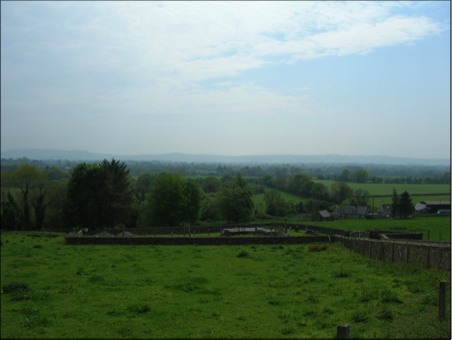
The supposition is that a monastery flourished here, founded between the 5th and 7th centuries. (www.megalithic.co.uk) That the monastery flourished is testified to by the presence of two High Crosses and the base of another. Whether founded in the 5th, 6th or 7th century, it was thriving during the 8th century, when it is supposed the crosses were carved. They have been identified as among the earliest of the Irish High Crosses. The original name of the site is not known, but at some point in history, the site was given the name Kilclispeen, St. Crispin’s Church. The ruins of a late medieval church are located on the site.
“The two stone crosses actually imitate wooden crosses that were encased in metal plates and are decorated with the type of geometric designs, interlacing and spirals found on contemporary metalwork. Both crosses have unusual bee-hive shaped hats that are only found on a few other crosses.” http://www.culturalheritageireland.ie/index.php/heritage-sites-and-centres/95-the-ahenny-high-crosses-near-carrick-on-suir-co-tipperary
The Cross
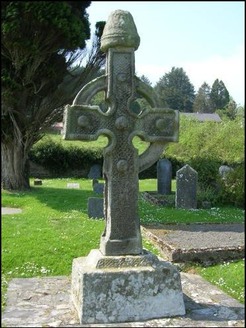
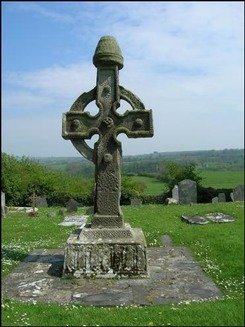
The Ahenny High Cross is located in a rural church yard in Co. Tipperary. It is one of two crosses found there. The photos above show, on the left the west face of the cross and on the right the east face. The cross stands about eight feet in height. Both the North and South crosses are carved of sandstone and probably date from the ninth century, an early period of stone cross making in Ireland.
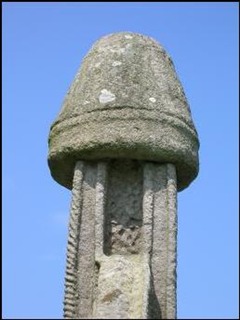
The cap of the Ahenny North Cross has been interpreted in a number of ways. Porter suggests it is an imitation of the miter of a bishop. Hilary Richardson sees it as connected with the dome shaped church of the Holy Sepulcher in Jerusalem. Helen Roe wonders if it was an original part of the cross or a later addition.
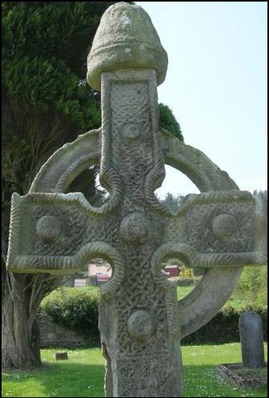
Peter Harbison describes the east face of the head of the cross, in part, as follows. “The head is formed of a single panel of interlacing in relief with the edges of the cross decorated with the same high-relief rope-moulding which formerly framed the shaft, where it has sadly been largely broken away. There are five decorative bosses — one on each arm and two on the shaft respectively above and below the fifth and largest one, which is at the centre of the head.” (Harbison 1992, 11)
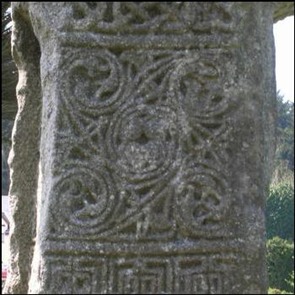
Moving down the shaft of the cross we find a zoomorphic design. Moving out from the center where there are four tightly woven coils, we have in each corner of the panel a spiral design that terminates in its center in three birds’ heads.
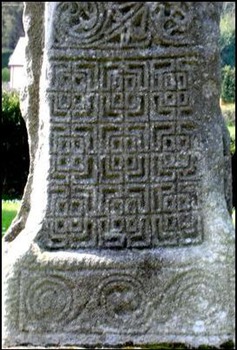
At the bottom of the shaft of the cross we have two panels. The upper of the two is composed of a pattern of squares-in-squares. The panel itself is square and there are nine large and many smaller ones within. L-shaped corners surround the nine large squares.
The lower of the two panels is on what is known as the plinth of the cross. In this space we have three interconnected spirals framed by rope-moulding.
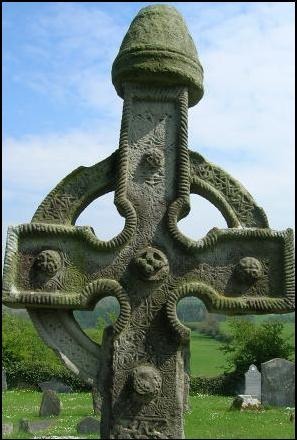
The head of the west face is quite complicated. “The head is covered like a spider’s web with a single panel of intricately-composed coiled spirals (some terminating in three animal heads), C-shaped scrolls back to back and S-spirals. A boss in the centre of the head has interlace on the side and, on top, four curious raised features radiating from the centre which Clavert suggested to be an equal-armed cross. The boss on the shaft beneath it is flat-topped and has interlace decoration. The other bosses — on the arms and on the upper limb — are dome-shaped and bear interlace ornament, arranged in such a way so as to leave a sunken cross-form in the centre.” (Harbison 1992, 13) In this way the theme of crosses within the cross emphasizes the importance of the symbol.
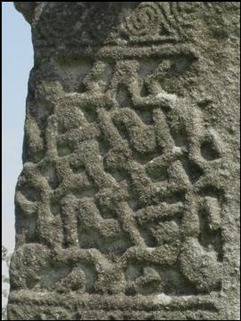
Moving down the cross we have an example of human interlace. There are four human figures, a head in each corner of the panel. The arms and legs are interlaced in a completely unnatural way.
What does this mean? Does it represent the interconnectedness of human community, or perhaps the tangle of human sin for which the cross is God’s response?
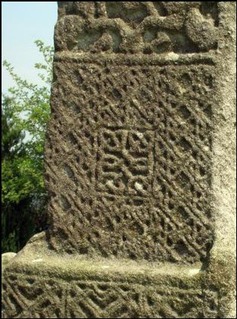
“The lowermost panel of the shaft, above the plinth, has a central square of interlacing surrounded by a diagonal fret pattern with vertical bars and interspersed diamond-shaped openings.” (Harbison 1992, 13)
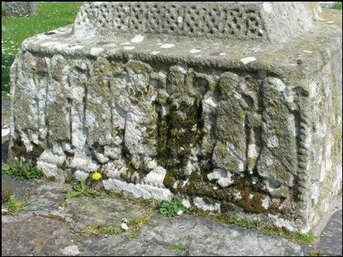
The base of the cross is carved on each side. The photo to the left shows the west face of the base. While interpretations of the scene vary, most scholars see the figure in the center as Christ and the flanking figures as Apostles.
Many have suggested this scene may depict the story of the mission of the twelve told in Mark 6:6-13.
References cited:
Halpin, Andy and Newman, Conor, Ireland: An Oxford Archaeological Guide to Sites from Earlest Times to Ad 1600, Oxford University Press, 2006.
Harbison, Peter; The High Crosses of Ireland: An Iconographical and Photographic Survey, Dr. Rudolf Habelt GMBH, Bonn, 1992. Volume 1: Text, Volume 2: Photographic Survey; Volume 3: Illustrations of Comparative Iconography.
Cary Meehan, Sacred Ireland,Gothic Image Publications, Somerset, England, 2004.